
New Blueberry Thyme Fragrance Oil – part of the Farmers Market Collection – is inspired by artisan cocktails that blend sweet and savory elements. It has notes of lemon, Spanish rosemary, and vanilla. Those notes inspired the design in this cold process recipe.
A combination of red sandalwood powder and Caribbean Blue Mica create light and dark navy shades. The sandalwood powder adds speckles for a natural look. Between each layer there’s a titanium dioxide pencil line to add interest. Finally, a fork is used to create texture on top and it’s finished with blackberry seeds.
 Blueberry Thyme Fragrance Oil discolors to a light ivory. You’ll notice the soap in these photos look slightly green, while the final bars look more blue. This could be due to the fragrance oil or the sandalwood powder – we aren’t quite sure. This recipe uses a low fragrance oil usage rate to keep any discoloration to a minimum.
Blueberry Thyme Fragrance Oil discolors to a light ivory. You’ll notice the soap in these photos look slightly green, while the final bars look more blue. This could be due to the fragrance oil or the sandalwood powder – we aren’t quite sure. This recipe uses a low fragrance oil usage rate to keep any discoloration to a minimum.
What You Need: Click below to add everything you need for this project to your Bramble Berry shopping cart!Blueberry Thyme Soap Tutorial
10″ Silicone Loaf Mold
1 oz. Castor Oil (2.9%)
8.7 oz. Coconut Oil (25%)
9.4 oz. Olive Oil (27%)
8.7 oz. Palm Oil (25%)
3.5 oz. Raspberry Seed Oil (10.1%)
3.5 oz. Sunflower Oil (10.1%)
4.9 oz. Sodium Hydroxide Lye
10.4 oz. Distilled Water (10% water discount)
1.5 oz. Blueberry Thyme Fragrance Oil
Red Sandalwood Powder
Caribbean Blue Mica
Titanium Dioxide
Black Oxide
Blackberry Seeds
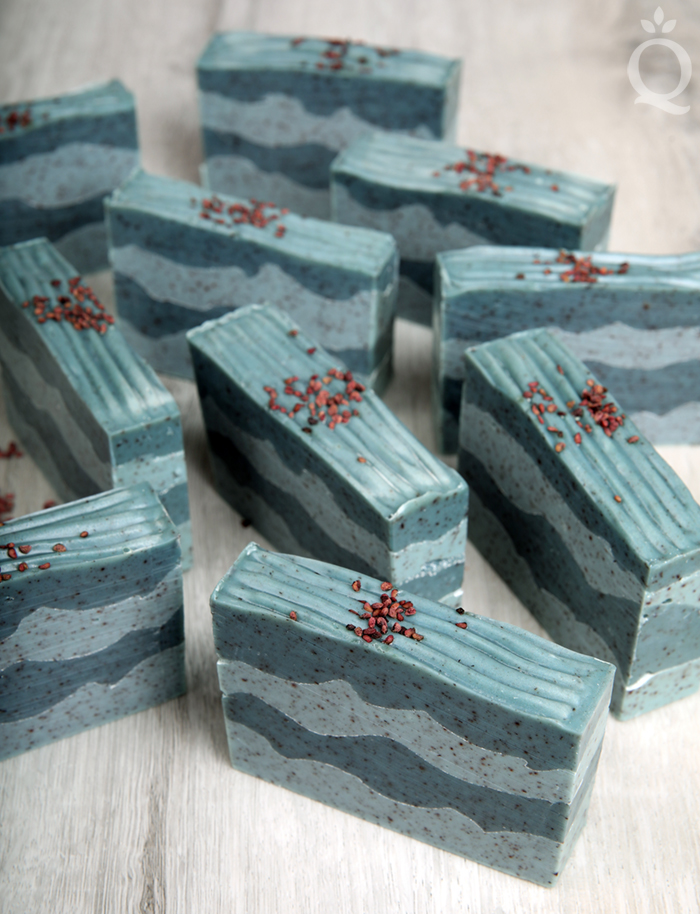
If you’ve never made cold process soap before, stop here. We highly recommend checking out our FREE four part SoapQueen.tv series on cold process soapmaking, especially the episode on lye safety. And if you’d rather do some reading, Bramble Berry carries a wide range of books on the topic, including Pure Soapmaking. You can also check out the digital downloads for that instant gratification factor.
FRAGRANCE PREP: Measure 1.5 ounces of Blueberry Thyme Fragrance Oil into a small glass container and set aside.
COLORANT PREP: Disperse 1 teaspoon of the titanium dioxide into 1 tablespoon of sunflower or sweet almond oil (or any other liquid oil). Use a mini mixer to get rid of any clumps. In a separate container, mix 1 teaspoon of Caribbean Blue Mica into 1 tablespoon lightweight liquid oil. Use a mini mixer to get rid of any clumps. Finally, mix 1/2 teaspoon of black oxide with 1/2 tablespoon lightweight liquid oil. Have 2 teaspoons of red sandalwood powder nearby.
Optional: To ensure the titanium dioxide blends smoothly into the soap batter, we recommend micronizing it before dispersing it in oil. Use a coffee grinder to break up any clumps of color and prevent streaks of white from showing in the final soap. We like to use a coffee grinder that has a removable stainless steel mixing area for easy cleaning.
SAFETY FIRST: Suit up for safe handling practices. That means goggles, gloves, and long sleeves. Make sure kids, pets, other distractions, and tripping hazards are out of the house or don’t have access to your soaping space. Always soap in a well-ventilated area.
ONE: Slowly and carefully add 4.9 ounces of lye to 10.4 ounces of distilled water and gently stir until the lye has fully dissolved and the liquid is clear. Set aside to cool. If you’d like a harder bar of soap that releases faster from the mold, you can add sodium lactate to the cooled lye water. Use 1 teaspoon of sodium lactate per pound of oils in the recipe. For this recipe, you’d add 2 teaspoons sodium lactate.
TWO: Melt and combine 1 ounce of castor oil, 8.7 ounces of coconut oil, 9.4 ounces of olive oil, 8.7 ounces of palm oil, 3.5 ounces of sunflower oil, and 3.5 ounces of raspberry seed oil (remember to fully melt then mix your entire container of palm oil before portioning). Add 2 teaspoons of red sandalwood powder directly into the oils. Use the stick blender to fully mix in and get rid of clumps.

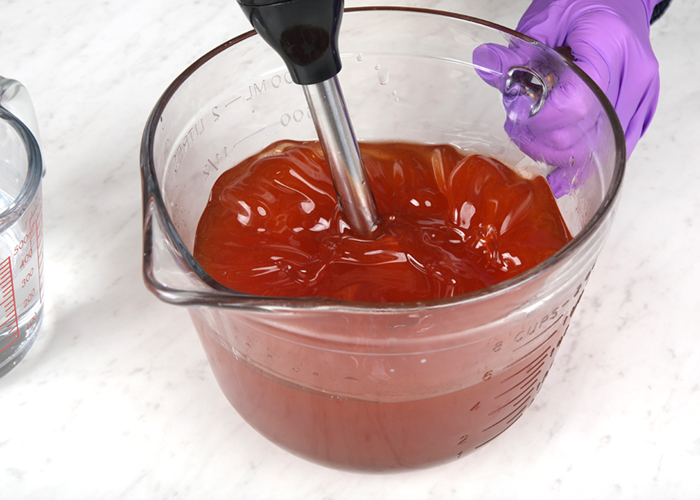 THREE: Once the lye water and the oils have cooled to 130 degrees F or below (and are ideally within 10 degrees of each other), add the lye water to the oils and stick blend the mixture to a thin trace.
THREE: Once the lye water and the oils have cooled to 130 degrees F or below (and are ideally within 10 degrees of each other), add the lye water to the oils and stick blend the mixture to a thin trace.
 FOUR: Add the 1.5 ounces of Blueberry Thyme Fragrance Oil and all of the dispersed Caribbean Blue Mica into the entire batch of soap. Use a stick blender to mix them in.
FOUR: Add the 1.5 ounces of Blueberry Thyme Fragrance Oil and all of the dispersed Caribbean Blue Mica into the entire batch of soap. Use a stick blender to mix them in.
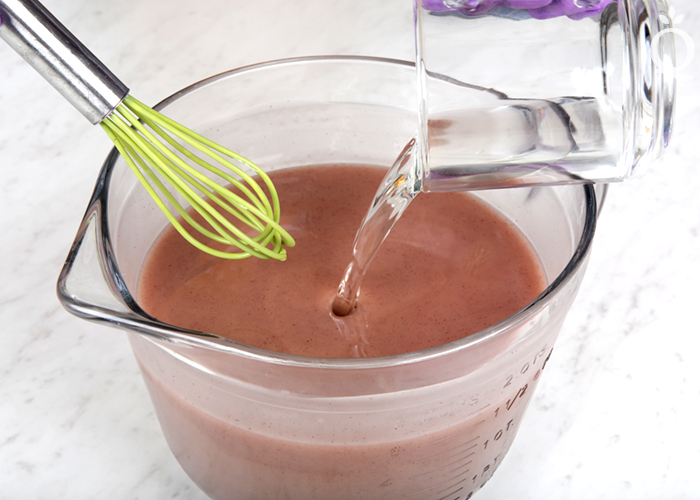 FIVE: Split the batch in half equally – each container will be about 750 mL. Add 1/2 teaspoon dispersed black oxide to one container and 1 tablespoon of dispersed titanium dioxide to the other.
FIVE: Split the batch in half equally – each container will be about 750 mL. Add 1/2 teaspoon dispersed black oxide to one container and 1 tablespoon of dispersed titanium dioxide to the other.
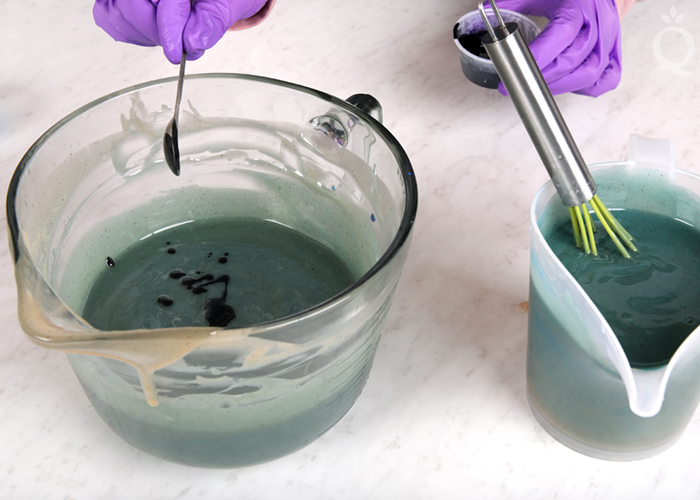 SIX: The soap batter needs to be a medium trace. If it’s still thin, pulse each container with the stick blender to thicken. It should be the texture of thick pudding.
SIX: The soap batter needs to be a medium trace. If it’s still thin, pulse each container with the stick blender to thicken. It should be the texture of thick pudding.
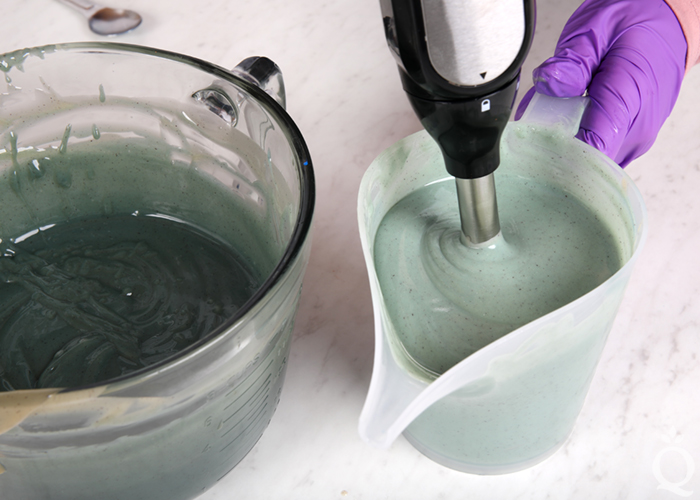 SEVEN: Pour half of the light blue batter into the mold and tap on the counter to level the soap. Use a spoon to create divots down the length of the mold. That gives the layers an interesting and rustic shape.
SEVEN: Pour half of the light blue batter into the mold and tap on the counter to level the soap. Use a spoon to create divots down the length of the mold. That gives the layers an interesting and rustic shape.
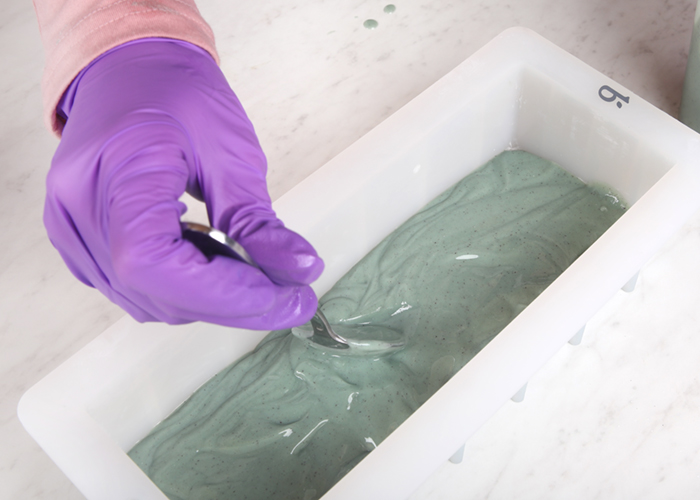 EIGHT: Add a few teaspoons of titanium dioxide to a Powder Duster or mesh strainer and sprinkle a fine layer across the soap. Be careful to use a small amount of titanium dioxide or the soap may separate when cut.
EIGHT: Add a few teaspoons of titanium dioxide to a Powder Duster or mesh strainer and sprinkle a fine layer across the soap. Be careful to use a small amount of titanium dioxide or the soap may separate when cut.
 NINE: Use a spoon to plop half of the dark blue soap on top of the light blue layer in the mold. Firmly tap the mold on the counter to help settle the soap and get rid of bubbles. Use a spoon to create divots down the length of the soap.
NINE: Use a spoon to plop half of the dark blue soap on top of the light blue layer in the mold. Firmly tap the mold on the counter to help settle the soap and get rid of bubbles. Use a spoon to create divots down the length of the soap.
 TEN: Dust another thin layer of titanium dioxide on top of the dark soap. Be careful to not make the layer too thick.
TEN: Dust another thin layer of titanium dioxide on top of the dark soap. Be careful to not make the layer too thick.
 ELEVEN: Dollop the rest of the light blue soap into the mold, tap on the counter, use a spoon to create divots, and dust with a layer titanium dioxide.
ELEVEN: Dollop the rest of the light blue soap into the mold, tap on the counter, use a spoon to create divots, and dust with a layer titanium dioxide.
 TWELVE: Use a spoon to gently dollop the remaining dark blue soap into the mold. Tap firmly on the counter to get rid of bubbles. Use a fork to create texture down the entire length of the mold.
TWELVE: Use a spoon to gently dollop the remaining dark blue soap into the mold. Tap firmly on the counter to get rid of bubbles. Use a fork to create texture down the entire length of the mold.
 THIRTEEN: Sprinkle blackberry seeds in the center down the length of the mold. Spritz 99% isopropyl alcohol on the top of the soap to prevent soda ash.
THIRTEEN: Sprinkle blackberry seeds in the center down the length of the mold. Spritz 99% isopropyl alcohol on the top of the soap to prevent soda ash.
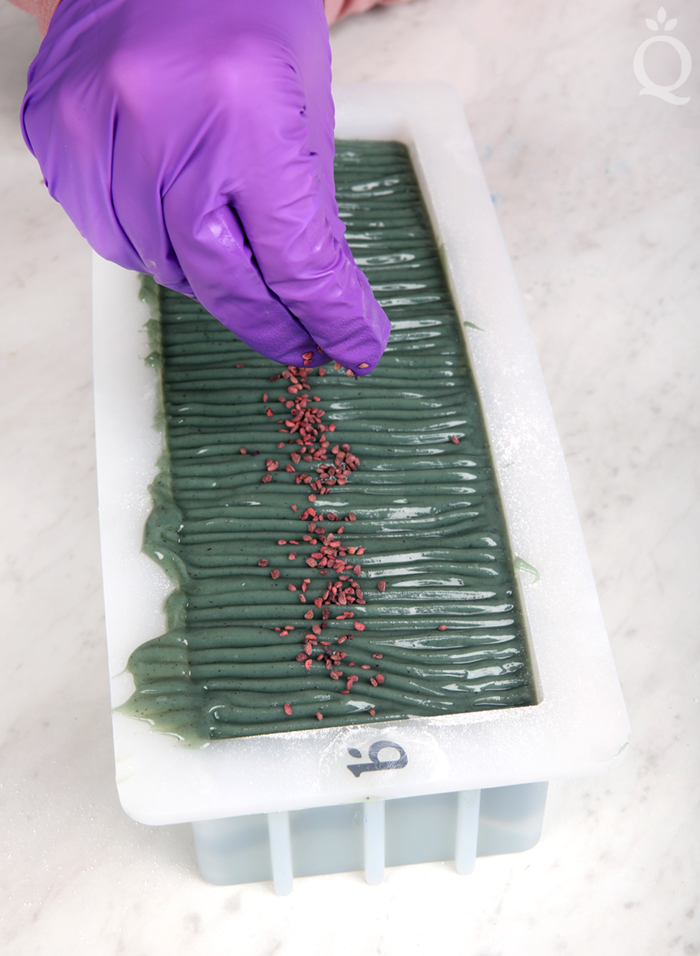 FOURTEEN: This soap benefits from being lightly insulated. You can place the soap in a drawer or other small space to stay warm. Allow the soap to stay in the mold for 2-3 days. Unmold and cut into bars.
FOURTEEN: This soap benefits from being lightly insulated. You can place the soap in a drawer or other small space to stay warm. Allow the soap to stay in the mold for 2-3 days. Unmold and cut into bars.
We recommend flipping and cutting the soap on its side to prevent the seeds from creating drag marks. That also prevents the titanium dioxide from smearing across the bars. If this happens (it happened to ours!), gently wiping the bars with 99% isopropyl alcohol and a tissue can help clean them up. The Soap Shaver also helps. Once cut, allow them to cure for 4-6 weeks. Enjoy.

- 10″ Silicone Loaf Mold
- 1 oz. Castor Oil (2.9%)
- 8.7 oz. Coconut Oil (25%)
- 9.4 oz. Olive Oil (27%)
- 8.7 oz. Palm Oil (25%)
- 3.5 oz. Raspberry Seed Oil (10.1%)
- 3.5 oz. Sunflower Oil (10.1%)
- 4.9 oz. Sodium Hydroxide Lye
- 10.4 oz. Distilled Water (10% water discount)
- 1.5 oz. Blueberry Thyme Fragrance Oil
- Red Sandalwood Powder
- Caribbean Blue Mica
- Titanium Dioxide
- Black Oxide
- Blackberry Seeds
- Slowly and carefully add 4.9 ounces of lye to 10.4 ounces of distilled water and gently stir until the lye has fully dissolved and the liquid is clear. Set aside to cool. If you’d like a harder bar of soap that releases faster from the mold, you can add sodium lactate to the cooled lye water. Use 1 teaspoon of sodium lactate per pound of oils in the recipe. For this recipe, you’d add 2 teaspoons sodium lactate.
- Melt and combine 1 ounce of castor oil, 8.7 ounces of coconut oil, 9.4 ounces of olive oil, 8.7 ounces of palm oil, 3.5 ounces of sunflower oil, and 3.5 ounces of raspberry seed oil (remember to fully melt then mix your entire container of palm oil before portioning). Add 2 teaspoons of red sandalwood powder directly into the oils. Use the stick blender to fully mix in and get rid of clumps.
- Once the lye water and the oils have cooled to 130 degrees F or below (and are ideally within 10 degrees of each other), add the lye water to the oils and stick blend the mixture to a thin trace.
- Add the 1.5 ounces of Blueberry Thyme Fragrance Oil and all of the dispersed Caribbean Blue Mica into the entire batch of soap. Use a stick blender to mix them in.
- Split the batch in half equally – each container will be about 750 mL. Add ½ teaspoon dispersed black oxide to one container and 1 tablespoon of dispersed titanium dioxide to the other.
- The soap batter needs to be a medium trace. If it’s still thin, pulse each container with the stick blender to thicken. It should be the texture of thick pudding.
- Pour half of the light blue batter into the mold and tap on the counter to level the soap. Use a spoon to create divots down the length of the mold. That gives the layers an interesting and rustic shape.
- Add a few teaspoons of titanium dioxide to a Powder Duster or mesh strainer and sprinkle a fine layer across the soap. Be careful to use a small amount of titanium dioxide or the soap may separate when cut.
- Use a spoon to plop half of the dark blue soap on top of the light blue layer in the mold. Firmly tap the mold on the counter to help settle the soap and get rid of bubbles. Use a spoon to create divots down the length of the soap.
- Dust another thin layer of titanium dioxide on top of the dark soap. Be careful to not make the layer too thick.
- Dollop the rest of the light blue soap into the mold, tap on the counter, use a spoon to create divots, and dust with a layer titanium dioxide.
- Use a spoon to gently dollop the remaining dark blue soap into the mold. Tap firmly on the counter to get rid of bubbles. Use a fork to create texture down the entire length of the mold.
- Sprinkle blackberry seeds in the center down the length of the mold. Spritz 99% isopropyl alcohol on the top of the soap to prevent soda ash. This soap benefits from being lightly insulated. You can place the soap in a drawer or other small space to stay warm. Allow the soap to stay in the mold for 2-3 days. Unmold and cut into bars.
- We recommend flipping and cutting the soap on its side to prevent the seeds from creating drag marks. That also prevents the titanium dioxide from smearing across the bars. If this happens (it happened to ours!), gently wiping the bars with 99% isopropyl alcohol and a tissue can help clean them up. The Soap Shaver also helps. Once cut, allow them to cure for 4-6 weeks. Enjoy.











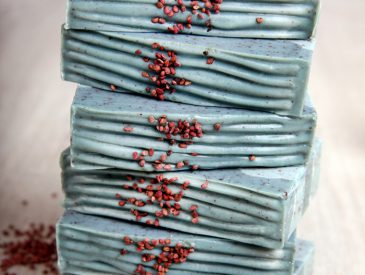





Can these be made using the Hot Process method?
Yes they sure can – pretty much any CP recipe can be done using the steps for hot process.
Would I be able to make this using grated rebatch soap? What adjustments would I have to make?
You can use rebatch to make a similar recipe though it wouldn’t look quite the same since rebatch is a thicker (rougher) looking consistency. You would want to use less fragrance oil and probably less color as well. Find out how much FO to use for Rebatch with our Fragrance Calculator.
https://www.brambleberry.com/Pages/Fragrance-Calculator.aspx
What is the reasoning for the titanium dioxide between layers? Is it just for looks, or is there a purpose?
It is just for looks to help the layers stand out a little more, like a mica line.
Hi! I made this today but didn’t have the Caribbean Blue Mica. I used instead the Cellini Blue Mica with the same amount. It looks like it completely disappeared in the soap. I have an orange layer and a black layer now. I noticed Cellini Blue Mica isn’t on the Brambleberry website anymore, so I can’t tell how it reacts in cold process. Does it not behave well in CP? I also substituted red palm oil for 1/2 of the palm oil. Could that have done it? It smells great though and I’m hoping maybe the colors change a little as it cures.
I can’t verify that information as we haven’t had the Cellini Blue Mica for quite some time. Red Palm can change the overall color of the soap but I would think you would experience more of a green color because you are adding red/yellow to the colorant you are using.
I used the colors and all other ingredients recommended but mine was way too thick, like cookie dough and one black layer and one very dark blueish-gray color. I actually blended it less than the recipe stated. What did I do wrong?
I get small bumps when cutting my soap with a wire cutter. Why is that?
It could be air bubbles that show up when cut. Can you describe the bumps?
about how many bars with one batch produced
This batch makes about 3 pounds of soap and 8-10 bars (depending on how thick they’re cut).
hi,can i use chacoral instead Black Oxide,and what a dose?
You can use charcoal. Mix 1 teaspoon of charcoal with 1 tablespoon of lightweight oil. Add 1/8th tsp. at a time until you get a color you like.
Activated charcoal: https://www.brambleberry.com/Activated-Charcoal-P4956.aspx
Is there an alternative to the Raspberry Seed Oil? Thank you!
You can use another lightweight oil like avocado or argan, or increase the olive oil to cover the difference. Remember to run the recipe through the Lye Calculator after any changes: https://www.brambleberry.com/Pages/Lye-Calculator.aspx
Avocado oil: https://www.brambleberry.com/Avocado-Oil-P3198.aspx
Argan oil: https://www.brambleberry.com/Argan-Oil-P5574.aspx
Ugh. I added two tablespoons of red sandlewood powder instead of two teaspoons. It is way dark! Oh well. This is only my second time making soap so chalk it up to inexperience.
Absolutely, that happens to us often. If you find the soap is bleeding color, you can rebatch it with equal amounts of uncolored soap. That will essentially dilute the color.
Learn more about rebatching soap here: http://www.soapqueen.com/bath-and-body-tutorials/cold-process-soap/soap-queen-tv-presents-how-to-make-rebatch-soap-2/
You can use our rebatch bases to mix in with the soap: https://www.brambleberry.com/Rebatch-Bases-C14.aspx
Can i make this using the sample size blueberry thyme i received?
You can. The sample is about 0.5 oz., so it won’t be very strong in this recipe. You may want to mix it with another scent to make it stronger.
Learn more about scent blending here: https://www.soapqueen.com/bath-and-body-tutorials/tips-and-tricks/fragrance-oil-blending-tips/
I’m getting a sample of this fragrance with my recent order and would love to give this a try. Based on this fragrance rec, I can downsize my recipe to 2 pounds. I only have the 8″ mold anyway and don’t want 3 lb. I downsize by dividing by 3 and then doubling that to get 2lbs!
Questions due to my not having all those ingredients:
-what does adding the red sandlewood do as far as the soap color?
-without the black ozide, will that darker layer still have color definition? If not, I can add more TD to the lighter layer right?
_the oils I know how to substitute using soapcalc.
I already have sweet almond, apricot kernel, or can get avocado oil.
The sandalwood powder adds the red specks and purple hue to the soap. You can make this recipe without it, but the color will be different.
I would recommend coloring one layer with just blue and then the other layer can be colored with blue and titanium dioxide. That will help you get the shade definition.
The soap looks amazing. For whatever reason I struggle a lot to get any sort of blue to come through on my soaps. And I struggle with the titanium white as well. No matter how much I mix it, the white never comes out as smooth as I would like. There is usually some blobs here and there. Anyways nice job on the soap, maybe I’ll give blue another try.🤔. 🙂
Have you tried micronizing the titanium dioxide? Basically, you put it in a coffee grinder to break down those particles. That helps prevent streaks of color and clumping.
As for the blue, are you noticing it looks more green? If that’s happening, it’s likely because the base is pretty yellow from olive oil. You can try using more neutral oils to get a true blue. This post talks more about that: https://www.soapqueen.com/bath-and-body-tutorials/tips-and-tricks/how-to-get-vibrant-colors-in-soap/
I was wondering if you could possibly replace blueberry juice for the water? I’d love to gift this soap to my local blueberry farmer, but I’d like to use their berries somehow. Thanks!
You can, but I would recommend making a small test batch first. Blueberry juice has a lot of sugar so it may scorch and change the color of the soap. I would recommend using blueberry juice with no additional sugar. You can freeze it before adding the lye to keep temperatures low, and then pop it in the freezer for 24 hours to keep it cool.
Learn more about working with fresh fruit here: https://www.soapqueen.com/bath-and-body-tutorials/tips-and-tricks/how-to-add-purees-to-cold-process-soap/
Good day
Could I use your quick lather mix for this recipe. I am still new to soap making. Love your tutorials and recipes. Would I still use the same amount of raspberry seed oil as well? Thank you for your help.
Yes, you can use the Lots of Lather Quick Mix for this recipe. Remember to run it through the Lye Calculator to get the correct amounts to use: https://www.brambleberry.com/Pages/Lye-Calculator.aspx
You can also find measurements on the product page: https://www.brambleberry.com/Lots-of-Lather-Quick-Mix-P5524.aspx
I would recommend adding the raspberry seed oil, as it can be tricky to factor it in when using the Lots of Lather Quick Mix. You can use the mix as is and it will feel great.
Your recipes always contain Palm Oil, what can I use to replace it with? Is there something that is equal to this so I dont have reconfigure the recipe? As I am just a beginner and still have no clue how to redo recipes. Thanks
Babassu oil can be used in place of palm oil: https://www.brambleberry.com/Babassu-Oil–P6807.aspx
You can also add a hard oil like cocoa butter up to 15% to add firmness like palm oil does. Coconut oil or tallow up to 33% work as well. Read more about common oils and what properties they add to soap here: http://www.soapqueen.com/bath-and-body-tutorials/tips-and-tricks/free-beginners-guide-to-soapmaking-common-soapmaking-oils/
This post on substituting oils has some great information too: http://www.soapqueen.com/bath-and-body-tutorials/tips-and-tricks/how-to-substitute-oil-in-cold-process-recipes/
Sodium lactate is helpful as well. It helps the bars unmold more quickly. You can add 1 tsp. of sodium lactate per pound of oils to your cooled lye water. Read more in the Sunday Night Spotlight: Sodium Lactate: http://www.soapqueen.com/bramble-berry-news/sunday-night-spotlight-sodium-lactate/
Can you use a melt and pour for this really cool soap?
You can create layers with melt and pour, but they will be straight instead of uneven like the photos above. This post talks about how to recreate cold process designs with melt and pour: https://www.soapqueen.com/bath-and-body-tutorials/tips-and-tricks/re-creating-cold-process-melt-pour-soap-designs/
This post has more tips on creating layered designs: https://www.soapqueen.com/bath-and-body-tutorials/5-tips-layering-melt-pour/
You can in fact get textured surfaces in MP, you just have to manipulate it before it is solid and take care to not puncture the skin.